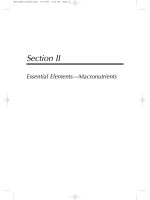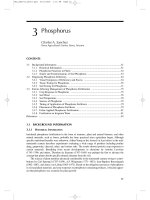Lecture Discovering nutrition - Chapter 9a: Spotlight on eating disorders
Bạn đang xem bản rút gọn của tài liệu. Xem và tải ngay bản đầy đủ của tài liệu tại đây (1.71 MB, 26 trang )
Spotlight on
Eating
Disorders
Eating Disorders
• Eating disorders ≠ disordered eating
– Eating disorder: Serious illness affecting
daily activities
– Disordered eating: Usually temporary or
mild change in eating patterns
The Eating Disorders Continuum
• DSM-5 assigns eating disorders to
categories across a continuum
– Self-starvation at one end
– Binge-eating disorder on the other
No Simple Causes
• Predisposition
• Social factors
– Expectations for body size and shape
• Psychological factors
– Peer relationships
– Family expectations
– Emotional trauma
No Simple Causes
• Biological factors
– Neurotransmitter levels
• Genetic factors
– Synthesis and release of leptin and
orexin
Anorexia Nervosa
• Diagnostic criteria
– Body weight < 85% of expected
(BMI ≥ 17.5 kg/m2)
– Intense fear of weight gain
– Distorted body image
– Amenorrhea
• Causes
• Warning signs
Anorexia Nervosa
• Treatment
– Goals
• Stabilize physical condition
• Convert patient into participant
• Restore nutritional status
• Gradual weight gain
– Psychotherapy
• Individual
• Group
• Family
Bulimia Nervosa
• Diagnostic criteria
– Recurrent binge eating
– Recurrent purging, excessive exercise,
or fasting
– Excessive concern about weight and
shape
– Absence of anorexia nervosa
• Causes
Bulimia Nervosa
• Binge: large amount
of food, short period
of time
– High-calorie, highfat foods
• Purge
– Affects fluid and
electrolyte balance
– Can be life
threatening
Bulimia Nervosa
• Treatment
– Medical
– Nutritional
– Psychotherapy
• Antidepressant medications
Binge-Eating Disorder
• Diagnostic criteria
– Recurrent binge
eating
– Distress over eating
behaviors
– No recurrent purging
– Absence of anorexia
nervosa
• Triggers of binge eating
– Stress
– Conflict
Binge-Eating Disorder
• Treatment
– Psychotherapy
• Antidepressant medications
– Long-term support
Body Dysmorphic Disorder
• Preoccupied with an imagined or slight
defect in appearance
• Often coexists with
– Obsessive-compulsive disorder
– Major depression
– Delusions
– Social phobia
Night-Eating Syndrome
• Habitual pattern of interrupting sleep to eat
• Indications
– Eats more than half of daily calories
during and after evening meal
– Wakes up at least once a night to eat
– Feels tense or guilty while eating
– Persists in behavior for 3+ months
Males: An Overlooked Population
• Fewer instances than females
• Most affected men are overweight, unlike
women
• Men involved in sports, modeling,
entertainment
– Pressure for certain weight or shape
Anorexia Athletica
• Sports-related eating disorders
• Body size/shape important in competition
• Pressure from coaches
The Female
Athlete Triad
• Disordered
eating
• Amenorrhea
• Premature
Osteoporosis
Other Issues
• Pregorexia
– Pregnant women who reduce
calories and exercise in excess
• Infantile anorexia
– Severe feeding difficulties beginning
with introduction of solid foods
Combating Eating Disorders
• Promote self-esteem
• Focus on size acceptance
• Celebrate the diversity in all sizes and
shapes
• Discourage meal skipping
• Encourage eating in response to hunger,
not emotions









